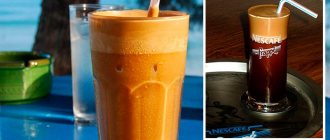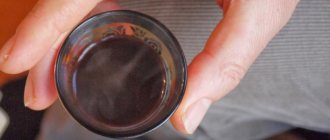People fell in love with coffee precisely because of the presence of caffeine in the beans, a stimulating and invigorating substance. But its effect is not beneficial for everyone, and today approximately 10% of coffee lovers prefer a drink that contains a minimal amount of stimulant while maintaining flavor and aromatic components. We tell you everything you didn’t know about decaf coffee, production methods, features, popular brands and much more.
Origin story
The discovery of decaf coffee happened by accident. In 1903, the ship of Bremen entrepreneur Ludwig Roselius, carrying a cargo of green coffee beans from Nicaragua, was caught in a severe storm and was holed.
The ship's holds were filled with water, and it was with great difficulty that it reached the port. It seemed that the goods were damaged. However, after drying and roasting the grain, it turned out that its qualities did not change with one exception: there was almost no caffeine left in it (5% of the norm).
To sell the “defective” batch, Roselius launched an advertising campaign based on a fictitious story about the death of his father from a heart attack, provoked by the caffeine allegedly contained in the drink.
The medicine of that time already had enough knowledge to support advertising with scientific justification. The product was sold out in a matter of days, and the enterprising German began to think about how to consolidate his success in the market.
Over the course of 3 years, Roselius, together with his assistant Karl Wimmer, improved the decaffeination method. To speed up the process, they used benzene as a solvent and in 1906 received a patent for their invention.
Caffeine down the drain
The opportunity to enjoy your favorite drink and not risk your health was given to people by the German coffee trader Ludwig Roselius. Moreover, like many brilliant discoveries, decaffeinated coffee was invented by chance.
In 1903, one of Roselius's ships, sailing from Nicaragua to Bremen with coffee on board, was caught in a storm and the precious cargo was spoiled by sea water. Upon the ship's arrival at the port, the businessman, in order to avoid losses, ordered the grains to be washed and fried. And then it turned out that their aroma and taste had changed little, but the drink no longer had its invigorating effect. Three years later, Roselius patented a technology for removing alkaloid from grains in the USA. And 24 years later, the first full-fledged advertising campaign for the new product was launched in the United States.
The technology used by the German trader was the first method of decaffeination and was called the Roselius Method. Today it is not used: this method involves the use of carcinogenic chemicals.
Ludwig Roselius
The Roselius method has been replaced by others, and not all of them are safe. If you think that information about decaffeination methods is not important, and that it is enough that there is no caffeine in coffee, you are mistaken.
Before considering these methods, let’s say that they all have a similar first stage: first, the grains are “opened” by treating with steam or placing in hot water. It is important to use hot water, but not boiling water: in the first case, the beans will swell, become softer and will “give off” caffeine faster, in the second case they will “slam shut” and will not “part” with it.
European method: using chemicals
It is also called classic or direct. After the grains have been “opened” with steam or water, they are placed in a solvent for 10 hours - methylene chloride (dichloromethane) or ethyl acetate. Then the solvent is drained, the grains are again placed in water to remove impurities, and then dried for 10 hours.
The traditional method is the most economical, but also the most unsafe method of decaffeination. Suffice it to say that in industry, toxic and carcinogenic methylene chloride is used to dissolve resins, fats, and glue plastics, and ethyl acetate is used as a solvent for fats and waxes and as a poison for insects.
Even after careful removal of the solvent, some of it still remains in the beans, changing their taste and aroma.
Swiss method: decaffeination with water
This method was developed in the late seventies by a Swiss company.
Green beans are dipped in hot water, causing them to release caffeine and aromatic oils. The water is then filtered through special filters. Caffeine settles on them, but the aromatic oils remain in the water. The grains are again placed in water purified from alkaloid and the procedure is repeated. This method allows you to obtain beans that are free of caffeine, but retain their full aroma and taste.
The Swiss method is the most environmentally friendly. But it also has its own significant disadvantage - high cost. Decaffeinated coffee obtained in this way is not available to all buyers.
Decaffeination with compressed gas
The method, invented by German specialists, is that after the initial treatment of coffee beans with steam or water, they are placed in chambers with compressed carbon dioxide. Under pressure from 73 to 300 atmospheres, the gas turns into liquid, taking caffeine from the beans. The CO2 is then evaporated, leaving pure caffeine. And carbon dioxide can be compressed and condensed again, that is, reused.
Like the Swiss method, this method is complex and requires a lot of energy, but it allows you to preserve all the richness of the aroma and taste of coffee.
"Caffeine-free" trees
In Brazil there are coffee trees whose fruits do not contain caffeine! Due to gene mutations, it contains another substance instead - theobromine (also present in cocoa beans). According to one version, “caffeine-free” trees were discovered back in the 80s of the last century. However, scientists fully described them only in the 2000s, and currently, using unique natural material, they are working on developing a new variety of decaffeinated coffee.
How is decaffeinated coffee made?
The Roselius-Wimmer method was used for more than 60 years until the harmful effects of treating coffee with benzene, which is a strong carcinogen, were discovered.
However, the technologies that appeared in the 70-80s used the same principles:
- initial soaking of coffee beans;
- elimination of caffeine by leaching;
- decaffeination using safe solvents.
CO2 extraction
In 1970, a method for producing a caffeine-free product using compressed carbon dioxide (CO2) appeared in Germany. After soaking for 8-10 hours, the grain is placed in an extractor, where the incoming gas is liquefied under a pressure of 150-300 atmospheres and at a temperature of +30...+60 °C. Extraction is carried out due to the low viscosity of supercritical CO2.
All the flavor and aroma properties of the coffee are preserved, and no traces of dioxide remain in the finished product.
To apply the method, complex, expensive equipment is required, which only large industries can afford (Jacobs, Lavazza, Melitta).
Equipment for producing a decaffeinated product using compressed carbon dioxide.
Direct method
The direct method is the technology used to produce most brands of decaffeinated coffee today.
The grain is decaffeinated in several successive stages:
- Treat green grains with water steam (30-40 minutes).
- Allow them to swell in hot water (1-2 hours) to fully open the pores.
- Soak for 10-12 hours in a bath with the addition of a solvent, which uses synthetic dichloromethane or ethyl acetate. Both actively bind caffeine molecules and are highly volatile.
- Evaporate all the solvent along with caffeine (9-10 hours).
Indirect method
The indirect exposure method is based on repeated (10-12 times) soaking of grains in a hot bath. After each soaking, they are removed and the solvent is removed from the water. This allows, while getting rid of caffeine, to keep all other flavoring substances in solution.
The method is considered too energy-intensive and time-consuming, and therefore is rarely used on an industrial scale.
Indirect method of decaffeination of beans.
Swiss method
The product obtained using the Swiss Water Process is considered the safest for health. The method is a type of indirect processing of coffee beans, but instead of chemical solvents, carbon filters are used to remove caffeine.
As a result of their use, up to 99.9% of caffeine is removed. Using SWP technology, elite coffee brands Egoist, Madero Columbia Decaf, Ambassador, etc. are produced.
Aromatic, but not invigorating - why drink decaffeinated coffee?
Author:
surgeon, ophthalmologist Sergey Pankratov
2 minutes
2144
Note that decaf is not a special type of coffee; for its preparation, ordinary coffee beans are taken and 97% of caffeine is removed, and according to European Union standards - 99.9%. The drink retains its nutritional qualities, taste and aroma, but loses its stimulating and invigorating effect that regular coffee has.
There are several methods of decaffeination, and generally the process begins by steaming the unroasted coffee beans. They are then placed in a solution that extracts the caffeine, leaving behind other important substances. Including antioxidants, which act as a shield in the body from the effects of polluted air.
Decaf is recommended for people who cannot take caffeine due to certain prescription medications, as well as for those who have trouble sleeping or suffer from anxiety. Caffeine consumption should be limited to pregnant and lactating women, children and adolescents.
However, anyone who wants to reduce their caffeine intake can switch to this type of coffee - for example, you drink a lot of coffee every day and are afraid that excess of this psychostimulant will negatively affect your health. You can also quietly drink a cup of coffee before bed without worrying about insomnia.
Three diseases associated with coffee consumption have been identified. In a large genetic study, the authors analyzed the relationship between coffee consumption and disease risk based on data from 333,214 participants in the British Biobank. The average permissible consumption limit per day is also named. Read the article
It is worth noting that the health benefits of this drink have been studied much less than that of regular coffee, but it has several obvious advantages:
It reduces the risk of type 2 diabetes, liver disease and death from stroke and heart disease
Scientists have linked drinking coffee, both regular and decaffeinated, to a reduction in the risk of developing type 2 diabetes by up to 7%. This in particular suggests that the protective effect is created not only by caffeine, but also by other substances contained in this drink.
The effects of decaf on liver function have been poorly studied, but one study found a link between drinking this drink and lower levels of liver enzymes, the increase of which indicates various diseases.
Drinking the drink was also associated with a small but significant reduction in the risk of premature death, as well as death from stroke or heart disease.
May reduce the risk of age-related neurodegenerative diseases
Research has shown that decaffeinated coffee may protect brain neurons, potentially preventing the development of Alzheimer's and Parkinson's diseases.
Scientists speculate that this may be due to chlorogenic acid, which is found in coffee.
Less likely to cause heartburn and reduce the risk of colorectal cancer
Scientists also found that drinking two or more cups of decaffeinated coffee reduces the risk of developing colorectal cancer by 48%.
Decaf has another important advantage: unlike regular coffee, it is much less likely to cause acid reflux, accompanied by heartburn and belching - this is one of the most common side effects. Decaffeinated coffee significantly reduces these symptoms.
Differences in the taste of coffee
Impact on coffee beans always negatively affects its taste, making the drink soft, lacking an invigorating effect, less rich and aromatic.
To compensate for losses, manufacturers resort to the method of intensive roasting of beans, but this creates a group of technological risks:
- the process is difficult to control;
- intensive heat treatment of grain leads to destruction of its structure;
- the drink acquires a bitterness unusual for a natural product.
The use of synthetic solvents makes the taste more sour, and natural ethyl acetate gives it fruit and berry shades uncharacteristic of an organic product.
Robusta or Arabica
When choosing a variety, manufacturers are guided by the cost of raw materials and the content of alkaloids in it. The caffeine concentration in Robusta is almost 2 times higher than in Arabica.
Removing it requires much more solvent, resulting in an increased acidity of the product. But the low price of robusta determines its predominance in the creation of soluble types of decaf, and the presence of 20-50% in brands of ground and bean decaf coffee.
Using 100% Arabica coffee reduces processing costs and keeps the taste and aroma close to the original.
If there is no information on the packaging about the percentage of varieties, then most likely the buyer is offered a low-quality caffeine-free product with an overwhelming predominance of robusta.
Robusta has twice the caffeine of Arabica.
Differences in the taste of decaffeinated coffee
No matter what anyone says or advertises, I have not yet come across a brand of decaf coffee that is not different, or I would even say, not inferior to regular bean coffee. They are all worse to one degree or another. They have not yet come up with either a solvent or a filter that would bind/retain/extract only caffeine from the beans and nothing else. Inevitably, other components are removed from coffee, the body of the drink becomes weaker, the taste is flatter, and the bouquet is simpler.
And the initially worse/older the grain, the more critical the changes. If the variety did not have a very pronounced taste before the decaffeination process, then after it it becomes completely bland. It is clear that manufacturers, in principle, use Arabica varieties with low caffeine content to make the process faster and cheaper. And low caffeine content often correlates with a bias towards acidity. It is clear that the cheaper the decaf in the store, the more shameful the original grain was. The process itself costs a significant amount, so good quality decaffeinated coffee must be more expensive than similar decaffeinated coffee.
As a result, after removing caffeine, the taste not only becomes poorer, but it also begins to become more sour, with wine notes, the bright shades, if they were there initially, are muted, and the bouquet becomes even. The aftertaste often reveals an astringent herbal taste or notes of unfinished baked goods. Which I personally don't like. Another thing is that if you bought a fairly expensive decaf, which is also freshly roasted (and freshly roasted coffee always has a brighter and richer taste), then these nuances can be considered a feature of the blend.
Composition and calorie content of coffee
The average calorie content for dry ground coffee is about 194 kcal per 100 g, and in a drink - no more than 5 kcal.
For a product to be considered good, it must contain:
- proteins 21%;
- fat 50%;
- carbohydrates 29%.
In addition, the standards stipulate that 100 g of high-quality decaf should contain:
- potassium -90 mg;
- phosphorus - 7 mg;
- calcium - 5 mg;
- iron (and compounds based on it) - at least 3 mg;
- vitamin PP - 0.6 mg.
Beneficial features
The main benefits of using decaf are:
- no signs of caffeine effects on the nervous system: insomnia, excitability, dizziness;
- preventing the development of diabetes, heart attack, stroke, cancer, lowering blood cholesterol;
- receipt by the consumer of a full complex of minerals and vitamins contained in the organic product;
- lowering blood pressure, improving gastrointestinal function, removing toxins from the body.
Coffee helps eliminate toxins.
Harm and side effects
In addition to caffeine, coffee contains other nutrients that are beneficial in small quantities but harmful to the body in large quantities. This should be kept in mind by people suffering from chronic diseases, for whom the transition to decaf is due to medical indications.
Cardiovascular complications
Residual traces of caffeine and synthetic solvents have an effect on the cardiovascular system. Excessive consumption of decaffeinated coffee weakens blood vessels and provokes exacerbation of heart attacks.
Decreased bone density
The leaching of calcium from bones is one of the negative properties of coffee, which does not depend on the presence of caffeine in it. To compensate for the harm caused by consuming decaf, it is enough to increase the proportion of foods in the diet that compensate for the lack of calcium (cottage cheese, cream, milk, nuts).
Increased bad cholesterol levels
Decaffeinated coffee increases the content of bad cholesterol in the blood by 17-20%, which leads to impaired elasticity of blood vessels, varicose veins, and the formation of cholesterol plaques.
Rheumatoid arthritis
Decaf itself does not cause disease. But it has been experimentally established that consuming more than 4 cups of caffeine-free product per day increases the risk of arthritis, and less than 3 cups sharply reduces this likelihood.
Metabolic acidity
Chemical solvents, due to their high alkaline content, cause chronic metabolic acidity. Its presence has a detrimental effect on the functioning of the gastrointestinal tract, bone structure, and the condition of the digestive system. The production of large amounts of gastric juice leads to heartburn, ulcers and gastritis.
Increased acidity contributes to the occurrence of gastrointestinal diseases.
Increased gastrin levels
Eating caffeine-free products increases the body's production of gastrin, a hormone that accelerates the release of acid in the stomach.
Caffeine as a substance
Caffeine is a purine alkaloid. It is found in the fruits, seeds and leaves of 58 plants; They need it to protect the leaves from insects that eat them and attract pollinators.
There are quite a few products in our diet that contain caffeine: coffee, green and black tea, dark and milk chocolate, cocoa, and even cola and Pepsi (the list is not complete).
Caffeine affects the central nervous system, which leads to a number of effects (psychological and physiological), including the control of muscle contractions and sleep-related processes. Caffeine increases blood pressure for a couple of hours (slightly, by 3–8 mm Hg) and increases heart rate. Although caffeine is a weak diuretic, it does not contribute to dehydration , despite a common myth.
Low doses of caffeine (20–200 mg per day - that is, up to 5 cups of double espresso for specialty coffee) improve mood, focus, and energy, but systematic use of too large doses (1500–2000 mg per day) can lead to anxiety, sleep disorders and other neuropsychiatric disorders.
For medical purposes, caffeine is used: in preparations for headaches, for migraines, as a respiratory stimulant for colds, to eliminate drowsiness, to increase physical and mental activity. It is also sometimes found in small quantities in painkillers, anti-allergy and weight loss medications.
As we can see, caffeine is quite a useful substance, although it is consumed in moderate doses. If you abuse it, it can lead to an overdose and unpleasant consequences.
Symptoms of caffeine overdose:
- Dry mouth
- Lack of appetite
- Insomnia
- Irritability
- Confusion
- Nausea
- Dizziness
Official sources claim that the optimal daily intake of caffeine is 400 mg.
We cannot know for sure how much caffeine is in our cup of coffee - the saturation of the drink with caffeine depends on many factors: the terroir of the bean, extraction and the ratio of water to coffee. But the dependence of caffeine capacity on the degree of roasting is observed to the least extent.
Is decaffeinated coffee okay for pregnant women and children?
Caffeine has always been contraindicated for women during pregnancy and breastfeeding. The impact of the alkaloid negatively affects the formation of the child’s nervous system, provokes increased excitability, reduces immunity and the body’s ability to produce a number of hormones (adenosine, cortisol, progesterone).
With the advent of decaf, the discomfort associated with giving up your favorite drink was eliminated, but its use should have restrictions:
- Pregnant women should not drink more than 2 cups (60 ml) per day;
- Nursing mothers are allowed up to 3 cups (75 ml each) after feeding.
The properties of decaf have not yet been fully studied, which means that it is not 100% safe to use. It is better to rely on the advice of a supervising specialist.
The benefits and harms of decaffeinated coffee (decaf)
Like many other products, decaffeinated coffee may or may not be beneficial, depending on the amount. Don’t think that it’s just caffeine - besides it, beans contain many other components that affect the body, so you shouldn’t drink 5-6 cups of decaf coffee a day.
Advantages:
- No side effects from caffeine such as headaches, dizziness, hand tremors, increased heart rate and nervousness.
- You get all the beneficial substances that are contained in a serving of a regular drink. Each cup of decaf coffee still contains antioxidants, manganese, magnesium, potassium and B vitamins.
- You can confidently drink a cup in the evening or even before bed, and your nervous system will not suffer from this in any way, you will easily fall asleep and get a good night's sleep.
Flaws:
- The drink will not bring any vigor, attentiveness, energy or concentration.
- Side effects associated with drinking coffee still remain: heartburn, acid reflux and other issues that acid causes.
- It does not help speed up metabolism and lose weight, since these effects are inherent in coffee precisely due to caffeine.
The effect of decaf on the body will be exactly the same as if you were drinking regular coffee, only without the stimulating effect.
Assortment of decaffeinated coffee
Today there is a large selection of decaffeinated coffee: beans, ground and instant. For the convenience of customers, decaf packages are marked with colored markers.
For this purpose it is customary to use:
- in the countries of the former USSR, blue, bright blue or (less often) green;
- abroad - orange.
Recently, easy-to-use capsules and teas for Nespresso coffee machines have become popular. They are widely used in the coffee chains Shokoladnitsa, Doubleby, Rockets Roasters, etc.
Grain
Decaffeinated coffee beans are offered to consumers by all manufacturing companies, as this is the simplest product that does not require any additional processing other than roasting. Average prices on the Russian market for a 250-gram package range from 550 to 800 rubles.
Top sellers are:
- ILLY Decaf 100% arabica, collected from 9 varieties of Arabica from all 4 continents where it is grown;
- Amado Maragogipe Nicaragua from giant beans (the size of a large raspberry), which has a rich, bright taste without a bitter aftertaste;
- Lavazza Qualita Rossa is a budget option (150-330 rubles), consisting of 20-25% robusta and having a characteristic sourness.
Coffee beans.
Ground
Prices for ground decaf vary greatly depending on the ratio of Arabica and Robusta in the blend, degree of roasting, quality of grinding, and decaffeination technology.
The most popular are:
- Dallmayr Prodomo (240 rubles for a 250 g package), which has a slight fruity-caramel flavor;
- ILLY Espresso (520 RUR), distinguished by its fine grind and velvety taste with hints of honey and chocolate;
- Lucaffe Decaffeinato (1 thousand rubles) with predominant notes of caramel and cocoa with a complete absence of bitterness;
- elite Swiss brand Altura (RUB 1,750 per 339 g jar), which is produced using SWP technology from 100% Arabica coffee.
Decaffeinated ground coffee.
Soluble
The most popular instant coffees are Jacobs Monarch, Grandos Gold, Nescafe Clasico Decaf and Moccona Douwe Egberts Pure.
How to make decaf coffee
At home, preparing decaffeinated and natural coffee is no different.
Water requirements
The most important point is the choice of water. It should be transparent and clean, without foreign impurities.
To do this, it is recommended to filter the water before cooking.
In the best catering establishments, bottled mountain, alpine or glacier wine is used for cooking, which creates a special taste effect.
Cooking rules
The most common algorithm for making coffee is:
- For 1 serving per 100 ml of water, take 6-7 g of ground product.
- The water is brought to a boil over low heat.
- It is cooled to 90 °C, after which it is poured with coffee grinds.
- Let it brew for 4-5 minutes.
Traditional methods of brewing ground decaf in a Turk are also popular: over a fire or in hot sand.
Standards of use
The critical consumption rate is 300-400 ml per day or 5-6 small cups of latte per day (no more than 75 g).











